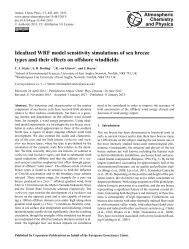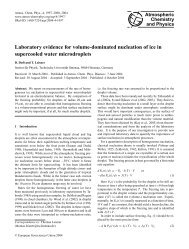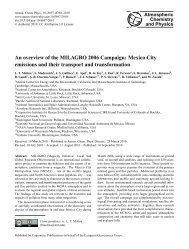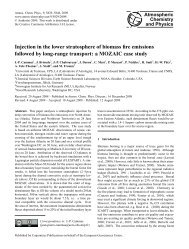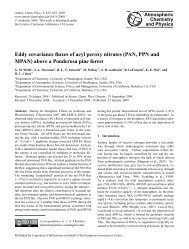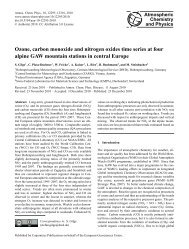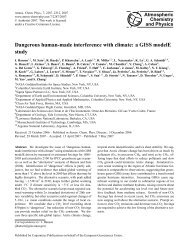A modified band approach for the accurate calculation of online ...
A modified band approach for the accurate calculation of online ...
A modified band approach for the accurate calculation of online ...
Create successful ePaper yourself
Turn your PDF publications into a flip-book with our unique Google optimized e-Paper software.
4146 J. E.Williams et al.: Online photolysis in Chemical Transport Models<br />
Fig. 6. As <strong>for</strong> Fig. 5 except <strong>the</strong> θ=93 ◦ .<br />
Table 4. The flux thresholds adopted <strong>for</strong> Fabs during <strong>the</strong> <strong>calculation</strong><br />
<strong>of</strong> <strong>the</strong> scaling ratios <strong>for</strong> <strong>band</strong>s 2 through to 4 at θ>81 ◦ . The ratio<br />
<strong>for</strong> Fabs/F0 is given using photons nm −1 s −1 <strong>for</strong> <strong>the</strong> original fluxes.<br />
These ratios hold <strong>for</strong> <strong>the</strong> scaling wavelengths given in Table 1.<br />
Band θ: 81–85 ◦ θ: >85 ◦<br />
2 1.2×10 −4 1.2×10 −4<br />
3 No limit 4.5×10 −12<br />
4 2.7×10 −5 1.35×10 −6<br />
numerical implementation we apply a limit on <strong>the</strong> resulting<br />
scaling ratios whenever Fabs falls below a selected threshold<br />
value, which effectively means using a δi value calculated<br />
<strong>for</strong> higher altitudes. The diagnostic used <strong>for</strong> <strong>the</strong> derivation <strong>of</strong><br />
<strong>the</strong>se Fabs thresholds was <strong>the</strong> occurrence <strong>of</strong> large associated<br />
errors on <strong>the</strong> most sensitive J values accompanied by correspondingly<br />
high δi values. In general, it was found that<br />
δi values greater than 10 resulted in an overestimation <strong>of</strong><br />
<strong>the</strong> resulting <strong>band</strong> contribution to <strong>the</strong> final J values. For<br />
species which exhibit strong absorption characteristics <strong>for</strong><br />
λ81 ◦ in order to reduce <strong>the</strong> associated error<br />
budgets. These were applied to <strong>band</strong>s 2 and 4 <strong>for</strong> <strong>the</strong><br />
species highlighted in red in Table 2. Once <strong>the</strong> θ>85 ◦ such<br />
limits were applied <strong>for</strong> <strong>band</strong> intervals 2 through to 4 <strong>for</strong> all<br />
chemical species, using <strong>the</strong> (Fabs/Fo) ratios given in Table 4.<br />
It should be noted that <strong>the</strong> ratios <strong>for</strong> <strong>the</strong>se limits change <strong>for</strong><br />
certain <strong>band</strong>s <strong>for</strong> incident angles above and below θ=85 ◦ as<br />
a consequence <strong>of</strong> using PIFM-PS at θ>85 ◦ , which modifies<br />
<strong>the</strong> Fabs component. No limits were applied to <strong>band</strong>s 1 or 5<br />
through to 8 under any circumstances. For <strong>band</strong>s 6 through to<br />
8 a sufficient amount <strong>of</strong> direct light penetrates through to <strong>the</strong><br />
lower layers so as to ensure that <strong>the</strong> main assumption used in<br />
<strong>the</strong> <strong>band</strong> model never fails, even at high zenith angles.<br />
A fur<strong>the</strong>r modification to <strong>the</strong> <strong>band</strong> <strong>approach</strong> is <strong>the</strong> introduction<br />
<strong>of</strong> a scaling ratio <strong>for</strong> <strong>the</strong> first <strong>band</strong>. An assumption<br />
is made in <strong>the</strong> original <strong>band</strong> <strong>approach</strong> that absorption dominates<br />
<strong>for</strong> λ≤202 nm. This assumption only holds when <strong>the</strong><br />
single scattering contribution to Fact can be neglected compared<br />
to Fabs. Here <strong>the</strong> single scattering contribution from<br />
a certain model layer scales with <strong>the</strong> transmission <strong>of</strong> <strong>the</strong> atmosphere<br />
located above that layer and <strong>the</strong> amount <strong>of</strong> radiation<br />
deposed in <strong>the</strong> model layer. Fur<strong>the</strong>rmore, <strong>the</strong> single<br />
scattering contribution is proportional to <strong>the</strong> single scattering<br />
albedo. However, this term does not depend on solar geometry.<br />
For θ72 ◦ <strong>for</strong> <strong>the</strong> first spectral <strong>band</strong><br />
which accounts <strong>for</strong> this behaviour.<br />
Atmos. Chem. Phys., 6, 4137–4161, 2006 www.atmos-chem-phys.net/6/4137/2006/



